
|
Manifest Technology Making Sense of Digital Media Technology By Douglas Dixon |
|
|
Articles: | PC Video | Web Media | DVD & CD | Portable Media | Digital Imaging | Wireless Media | Home Media | Tech & Society | Home Media: | Home Media Articles | Home Networked Media Gallery | Holiday Tech Gift Guide 2009 (11/2009, 12/2009)
|
 |
The MiFi serves as a Wi-Fi router over cellular broadband, supporting up to five simultaneous wireless connections, including laptops and other portable devices. Getting online couldn't be easier -- any Wi-Fi device can now be connected anywhere, without needing to search for a hotspot. And the MiFi is tiny, at around 3.5 x 2.3 x 0.4 inches, and light, at just over 2 ounces. It's powered through the USB port, or runs on the battery for up to 4 hours of active use, or 40 hours on standby. It's available for $99 from Verizon Wireless with a two-year service plan.
|
However, while the cellular carriers offer "unlimited" service plans for voice calls and even some smartphones, they are not thrilled about the idea of offering bottomless data service for computers -- users could swamp the mobile network by watching streaming video or downloading files all day. As a result, the Verizon mobile broadband data plans for the MiFi have service caps, starting at $39.99 per month with a 250 MB monthly allowance (and then 10 cents per MB overage), or $59.99 a month with a 5 GB monthly allowance (5 cents per MB overage). Or you can pay as you go with a DayPass plan at $15 for 24-hour access.
Yet another approach to finding computer-like functionality in a relatively inexpensive portable device is, of course, to use a computer. But you pay a premium for squeezing high tech components into lightweight laptops like the Apple MacBook Air, with 13.3" screen, Intel Core 2 Duo processor, and 120 GB hard drive, starting at $1499 (www.apple.com/macbookair).
Instead, consumers are turning to a new category, the Netbook computer, designed to be easy to carry and easy to connect to the Internet (see Wikipedia, http://en.wikipedia.org/wiki/Netbook). Netbooks have a larger screen than pocket devices plus a full keyboard, but with lower performance and capacity. They typically run Windows XP or Linux, with your favorite typical applications, and are great for basic document editing, web access and email, and even playing web videos, but really are not designed for activities like 3D games or video editing.
 |
Sample Netbook products
|
Netbooks are typically a third to one half the size of traditional laptops, and weigh around 2 to 4 pounds. They have smaller, 7 to 10 inche displays, with adequate memory (1 GB) and storage (more like 10's to 100 GB). And they typically use the Intel Atom processor, designed specifically for mobile use with low power and low heat, and lower speed (1+ GHz, www.intel.com/products/processor/atom).
But the "Net" part of Netbooks is about connectivity, so they have Wi-Fi wireless built in. And they typically also support mobile broadband service, although this requires yet another service contract with a cellular carrier. Some carriers even are offering discounted netbooks, like they discount other mobile phones, as long as you sign up for a long-term service plan.
But if you still to take "it" all with you, in a pocket-sized device, then you really need a smartphone. But what is a smartphone? It's a phone plus Internet, connectivity and storage, text and multimedia, and more, all in one multi-tasking device.
Interestingly, these devices are no longer primarily defined as phones -- neither the Apple iPhone nor the Verizon Droid (Android) phone have dedicated phone keys; Instead you place calls from your contacts list and answer on the touchscreen display. More generally, smartphones are Internet communications devices, with text messaging, instant messaging, email, and now visual voice mail. And they are PC replacements for Internet access, with more devices adding Wi-Fi for enhanced web browsing and downloads, plus built-in GPS for location-based maps and services.
Smartphones are expected to be media players -- the iPhone obviously through iTunes, and others in less integrated ways -- as well as media recorders with camera and microphone. Plus the Internet connection opens up streaming media playback and uploading your own media to share online. However, some smartphones have less emphasis on serving as personal digital assistants (i.e., evolved from Palm products) -- with less focus on features like managing tasks and notes, or integration with desktop Outlook data.
As smartphones have become more interesting, they have outperformed mobile phones even in this difficult economy. According to research from Canalys, global smartphone shipments grew 4 percent over the year, to 41.4 million units in Q3 (www.canalys.com).
The relative ranking of smartphone platforms remained relatively stable over the last year (comparing third quarter 2009 to 2008): Nokia / Symbian lead with 46% (was 47%), RIM BlackBerry grew to 21% (was 15%), Apple iPhone increased to 18% (was 17%), Microsoft Windows Mobile dropped to 8.8% (was 13.6%), and the new Google Android grabbed 3.5%.
Yet while there's a lot of cheerleading about "battles" between these different platforms (and the latest "iPhone killer"), these products are actually very clearly differentiated for very different target markets. Each has significant lock-in that will not make it easy for users to switch platforms on a whim.
At a high-level view:
And there's more lock-in -- These mobile devices are also developer platforms, so the push for signing up developers to build third-party application software has now extended from the desktop (remember Windows vs. Macintosh?) to portable environments. The next step in convergence is all about the "apps."
Apple already has more than 100,000 applications available as of November, and the over 50 million iPhone and iPod touch users have downloaded over 2 billion apps. Competitors like Microsoft and Google and Palm are developing their own application stores, but are far behind.
So Apple's strength is not just in the sexy hardware. Its products also come with the now dual ecosystems around the iPhone and iPod touch: the desktop integration with the iTunes Store to organize and purchase music, movies, TV shows, and more (www.apple.com/itunes), plus the wireless integration with the iPhone App Store to download free and inexpensive software applications to customize your device (www.apple.com/iphone/appstore).
So the Apple iPhone continues to define the category for smartphones (www.apple.com/iphone).
 |
Apple upgraded in June to the iPhone 3GS, with improved speed and performance, hands-free voice control, and a higher-res 3 megapixel auto focus camera that now records video. It's a little bigger then the iPod touch (4.5 x 2.4 x 0.48 inches, 4.8 ounces), and available with 16 GB for $199, and 32 GB for $299 from AT&T. |
Microsoft also updated its smartphone platform in October to Windows Mobile 6.5, now rebranded as Windows Phone in case the PC connection was not clear enough (www.windowsphone.com). The software platform is available on a wide variety of hardware phone designs from many manufacturers, with tools like Office Mobile to edit your documents, Media Player Mobile for playing music and video, and Internet Explorer Mobile for web browsing.
 |
The AT&T HTC Pure, introduced in October, is a touchscreen Windows phone priced at $149 from AT&T (att.com/htcpure). The Pure is a compact handheld design, with most of the front taken up by the 3.2-inch touchscreen display. Its features include a 5 megapixel auto-focus camera, FM radio, built-in Wi-Fi for faster web access, GPS, and haptic feedback (vibration) on button presses.
|
In addition, the new Microsoft My Phone service syncs your phone data to the web so it is backed up and accessible if you lose your phone or upgrade to a new model (http://myphone.microsoft.com). Plus, you can use it to chase down a misplaced phone -- forcing it to ring, locating it on a map, or even wiping it remotely if it is truly lost.
While Windows Mobile 6.5 is a step towards making the Windows Phone platform more touch-friendly, the underlying tools still retain the Windows desktop feel with small menus and controls, so the phones still include a stylus (unlike the iPhone and Droid).
The latest innovation in the smartphone market, however, is the Verizon Wireless Droid smartphone from Motorola, which shipped in November (www.droiddoes.com). This is the first phone based on the updated Google Android 2.0 mobile phone software platform (www.android.com). It's priced at $199 from Verizon, with a new 2-year agreement.
 |
The Droid is designed as a slider phone with a full QWERTY keyboard, with a large 3.7 inch display at significantly higher resolution (854 x 480 versus 480 x 320 for the iPhone), plus a 5 megapixel camera with LED flash. It has a solid feel, and is a bit thicker and heavier than other designs (4.56 x 2.36 x 0.54 inches, 5.96 ounces). It includes integrated Wi-Fi for fast communications and browsing, and GPS for location-aware searching and mapping -- including free real-time turn-by-turn Google Maps Navigation. The Android 2.0 platform also supports fully-integrated voice search and real multi-tasking, so, for example, applications download quietly in the background as you continue using the device.
|
The Android platform is focused on syncing to your life online in the Google cloud, with Gmail and Google Contacts and Calendar. The new version 2.0 does extend to more traditional business uses (multiple accounts, Exchange support).
However, the Droid missing common functionality that will be expected by people interested in switching from PDA phone platforms like Windows Mobile and Palm. Particularly glaring are the absence of out-of-the-box support for syncing desktop data and files (as in Outlook and Office documents), and limited media player support, with no built-in support for managing and syncing media as we're used to from iTunes.
While smartphones aim to do it all, there is also still a place for handheld devices that are focused on specific uses, including media players, game systems, and E-Book readers. As dedicated devices, these can be designed to better meet the primary use, for example with widescreen displays, game control pads, or E-Ink displays.
Yet even the designers of these dedicated devices can't stop packing in additional features to cross into other categories, so you can play at least some media and games on almost any portable device. And now many handheld devices are also adding Wi-Fi wireless connectivity, to access online content and services, or even to provide general web browsing. It's that convergence thing, each moving toward a common set of features from different directions.
Clearly, portable media players have retained their broad popularity, as they have extended from MP3 music players, to video players, to even more multi-function devices. And portable devices are going wireless with Wi-Fi connectivity, with more open support for accessing information and media over the Internet, instead of having to download and sync from a PC.
 |
The third generation Apple iPod shuffle from March 2009 doubles the capacity (4 GB for $79), chops the size in half, and removes the controls! It's around the size of 2 AAA batteries (1.8 x 0.7 x 0.3 in. including clip, and 0.38 oz.), with a volume of a quarter of a cubic inch (www.apple.com/ipodshuffle). It's available with 2 GB for$59, 4 GB for$79 Since the shuffle is now too small for a control pad, the controls have been moved to a remote on the right earbud cord. A new "VoiceOver" feature will talk to announce the songs, and also helps to choose the playlist you want to hear by having the shuffle speak their names.
|
 |
The Apple iPod nano is the exemplar of a small video player, in an amazingly sleek and colorful package (3.6 x 1.5 x 0.24 inches, 1.28 ounces). But the new iPod nano, introduced in September, breaks Apple's image of simplicity by piling on advanced features previous found only in competitive products (www.apple.com/ipodnano).
|
This fifth generation update adds a slightly larger screen (from 2 to 2.2 inches diagonal) with 8 GB for $149, or 16 GB down to $179. But then Apple pours in more functions -- somehow squeezing in a microphone and speakers, and FM radio, plus a video camera (but not photo) , and even a pedometer.
You can't ask for much more in a small player, but with a slightly larger package you can get a bigger and more readable screen, trade in the dedicated control pad for a touch-screen interface, and add Wi-Fi wireless connectivity to access and download online content.
 |
The Apple iPod touch again defines the category of wireless media player. Also refreshed in September to its third generation, it's basically an iPhone without the phone stuff (or camera), with a 3.5 inch touchscreen display good for browsing the web over Wi-Fi (www.apple.com/ipodtouch). It's still pocket sized (4.3 x 2.4 x 0.33 inches, 4 ounces), with 8 GB for $199, 32 GB for $299, and the new 64 GB for $399.
|
 |
The new Microsoft Zune HD, introduced in October, to add the HD, features a bright 3.3" touchscreen OLED (Organic Light-Emitting Diode) display, with a new full-screen web browser (www.zune.net/zunehd). It's available with 16 GB for $219 and now up to 32 GB for $289. You also can download and stream music over Wi-Fi, and download games and other applications. The new Zune is a bit bigger and heavier (4 x 2 x 11/16 inches, 2.6 ounces).
|
The new Zune now supports digital HD Radio. However, the "HD" in the name actually is for the new support for downloading HD video -- although viewing the video in full HD requires a separate AV Dock accessory connected to your HDTV.
But once you're using these kinds of devices for significant web browsing, another boost to the size of the display can raise the possibility of replacing your laptop, at least on some trips.
 |
So the Archos 5 Internet Tablet introduced in November has a 4.8 inch touchscreen display (at around 5 1/2 x 3 inches), so you get a much better screen-width view of web pages (www.archos.com/products/imt/archos_5it). It's available with 32 GB of flash memory for $379, and with a hard drive with 160 GB for $399 up to 500 GB for $499.
|
As with the previous devices, flash storage lowers the weight compared to higher capacity hard drives (6.4 versus 10.1 ounces for the Archos tablet).
The Archos tablet also runs the Google Android operating system, which is designed for mobile devices (like the Verizon Droid) and is built on the Linux kernel as an open source project (www.android.com). The Archos tablet includes tools for web browsing, email, and messaging; apps for connecting to sites like Twitter and Wikipedia; contacts and calendar; tools for working with office documents; and media players.
While media players have evolved into wireless web devices, and are adding downloadable applications for fun and gaming, there is another class of devices that is converging from a different direction -- portable game systems like the Nintendo DS and Sony PSP families that are also portable media players with wireless access. These are mass market products -- as of the beginning of this year, Sony has sold over 50 million PSP handhelds, and Nintendo has sold over 95 million DS models.
These systems have built-in Wi-Fi and support some wireless access, albeit using game controls, but are obviously more focused on wireless gaming with others. But the real value in wireless for these companies is to expand portable devices from a product to subscription services, linking you with the associated Sony and Nintendo online stores for buying media and games.
In any case, handheld game systems are for more than just the kids -- if you're an gamer dreading a long plane flight, these devices go beyond media players to offer commercial game titles and dedicated gaming controls that can make your trip pass much more quickly.
 |
And the dual-screen Nintendo DSi, introduced in April, is smaller than the previous DS models at 5.4 x 2.9 x 0.74 inches, and is priced at $169. It features two 3.2 inch screens plus two lowish-res 0.3 MP cameras (to shoot in towards you and out) (www.nintendodsi.com).
|
 |
The new Sony PSPgo, introduced in October, has a 3.8 inch display that slides to access the PSP gaming controls. It's smaller than the previous PlayStation Portable designs (4.8 x 2.6 x 0.6 inches, 5.6 ounces), and priced at $249 (www.us.playstation.com/PSP).
|
Portable media players and handheld gaming systems are fine for quick web browsing, but the 3-inch screens are not great for extended viewing, especially if you are reading text.
To expedite your purchases, and avoid the pain of having to sync books though a PC, the Amazon Kindle and the Barnes & Noble Nook include a built-in cellular modem (with Sprint and AT&T data service, respectively) that can connect directly to the bookstore servers to browse and download titles to preview and buy. The service comes with the device, there's no additional monthly charge. The Nook also adds Wi-Fi for faster access, with free service at Barnes & Noble stores.
 |
So E-Book readers like the Amazon Kindle feature 6 to 9 inch grayscale screens, closer to the experience of reading an old-fashioned paper book (www.amazon.com/kindle). The Kindle with 6 inch screen is now $259, and holds some 1,500 books in the size of a tablet (8 x 5.3 x 0.36 inches, 10.2 ounces). The larger Kindle DX has a 9.7 inch screen for $489 and holds 3,500 books (10.4 x 7.2 x 0.38 inches, 18.9 ounces).
|
 |
The recently announced Barnes & Noble Nook, which should be generally available in early 2010, is a bit thicker and heavier than the Kindle (7.7 x 4.9 x 0.5 inches, 11.2 ounces), but adds a 3.5 inch color touchscreen display below the E-Ink screen for control and navigation, microSD slot for expansion storage, and replaceable battery for $259 (www.nook.com). The Nook based on the Google Android platform, which may open it up in interesting ways. |
The big difference with E-Book readers, however, is the E-Ink "electronic paper" display, where the dark "ink" dots drawn on the page remain permanently until the display is re-written -- unlike LCD displays which need power to remain lit, and which therefore need to be automatically turned off when not in use. As a result, the Kindle can run on its battery for 4 days, or two weeks with the wireless turned off.
But, once you have an intelligent portable device with a large display and wireless service, these are other useful functions that it can perform. So while the Kindle and Nook are not suitable for motion video or action games, or color images, they do have some general player features, including displaying PDF files, playing audiobooks, serving as a music player and photo viewer, and even including basic web browsing, albeit best for text-centric sites.
Amazon reports that the Kindle is the best selling item (in both unit sales and dollars) across all product categories on Amazon.com. But like songs and movies on iTunes and apps on the iPhone, the real action is in the online store: As of November, Amazon offers more than 360,000 books in the U.S. Kindle Store, including 101 of 112 New York Times bestsellers, as well as more than 90 U.S. and international newspapers and magazines. And Barnes & Noble has more than a million titles available.
Both Amazon and Barnes & Noble are extending their services from E-Book devices to PCs (and Macs) and other portable devices, including the iPhone, iPod touch, and BlackBerry. Amazon automatically syncs your bookmarks and last page read across devices so you can continue reading on what ever device is handy at the moment, and Barnes & Noble supports "digital lending" of titles to friends across the different platforms.
This is the year that all that talk about "convergence" has really come to fruition in portable devices. These devices have reasonably big and bright displays, with touchscreen control. They connect wirelessly, from anywhere by cellular, and faster at Wi-Fi hotspots. They communicate across the phone system with voice and messaging, and across the web with IM to e-mail. They manage contacts and calendars and documents, and sync with the desktop and the cloud. They locate you on maps and navigate with GPS. They sync and play media, and download and stream clips over the Internet, and then shoot more with built-in cameras.
But this year there's an entirely new level: the introduction of "apps" -- literally hundreds of thousands of software applications available to customize your device, many even for free. So while your portable device may be a stand-alone multi-function powerhouse, but it's actually being more entangled with integration with other data and services and app marketplaces.
This is good news for consumers in terms of choosing and customizing their one device that can do it all, keeping you organized and entertained and connected wherever you are. And it's good news for manufacturers and service providers, encouraging your lock-in to their platforms as you become more enamored with specific apps and connected to their services. The lock-in is further strengthened to the extent that you buy copy-protected content, from E-books to music to videos, that might be no longer accessible on your future platforms.
So it's no longer just a question of which device, it's also a question of which services, which ecosystems that make sense for you -- Desktop syncing with Outlook / Exchange, media management and purchases through iTunes, and/or interfacing online with the Google cloud.
It's your data, your life, your interests, that you can organize, carry, and access wherever and whenever you need it. Enjoy it!
As we have seen, as a market matures, it's tempting to bulk up new versions of products with additional options and features, so that, for example, smartphones and even media players now include video cameras. But it's still useful to have more dedicated and higher-end camcorders for shooting important events in higher quality. Interestingly, there's also a place in the market between camera phones and more traditional digital camcorders -- pocket camcorders that are easy to carry, simple to use, and fun to share -- And yet still shoot with rather good quality.
The RCA Small Wonder line offers a broad array of different models and designs, with features including removable batteries, expandable memory slots, flip-out displays, and a DVD recorder dock (www.mysmallwonder.com).
 |
The RCA EZ209HD Small Wonder 720p HD Digital Camcorder, introduced in March for $129 / $89 street, shoots 720p HD video in a slim design (~ 4.3 x 2.5 x 0.9 in., 12.8 oz.). It has a 2” LCD display with 256 MB internal memory plus SD card expansion up to 16 GB. It has 3 video recording modes (lower-res Web 320 x 320 at 30 fps, high-speed Sports 848 x 480 at 60 fps, and HD 1280 x 720 at 30 fps -- for 40 to 8 hours recording on a 16 GB card. It also shoots photos at 8 MP (extrapolated from 5 MP sensor), with Auto, Outdoor, Indoor, Low light settings.
|
The JVC Picsio Pocket Flash Memory Camera, released in October, adds image stabilization technology in a small camcorder. These cameras are so small and light that it is difficult to brace yourself and hold them steady so you don't end up with shaky video.
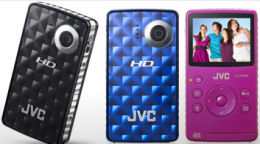 |
The JVC Picsio Pocket Camera for $199, shoots video in Full-HD 1080p resolution and still photos up to 8 megapixels with a macro mode, and uses SDHC cards for up to 32 GB of storage (www.jvc.com/press/index.jsp?item=725&pageID=1). It's still pocket sized and very light (3 7/8 x 2 1/8 x 11/16 in., 3.4 oz.). The case has a jewel-like geometric pattern with chrome accents, and is available in three colors - Black Ice, Blue Steel, and Purple Passion.
|
In contrast, the Flip Video line (now part of Cisco) has had great success by maintaining its focus on simplicity, so you just power on and shoot, without worrying about set-up or options (www.theflip.com).
Flip line has two models: the sleek Flip Mino at around 3.3 ounces, and the slightly larger Flip Ultra with removable batteries at around 6 ounces. Each of these models is available in two versions, standard-definition (VGA 640 x 480) and HD (720p, 1280 x 720). The Ultra models have 2 inch screens and shoot for two hours, while the compact Mino models have smaller 1.5 inch screens and shoot for only one hour. (The HD models look and work the same as the SD versions, they just shoot in higher resolution -- and have double the storage to provide the same recording time.)
Plus - Cisco has reportedly stated that the Flip line will add integrated Wi-Fi coonectivity early in 2010.
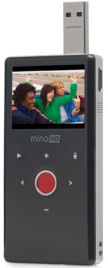 |
The new Flip MinoHD 120 minute model, introduced in October for $229, doubles the recording time of the original Flip MinoHD 60 min. model, increases the screen size to 2 inches (matching the Ultra), and adds a HDMI connector so you can play videos directly on an HDTV. Yet it still keeps the same form and size -- albeit with a new brushed metal front so it's slightly heavier, growing from 3.3 to 4 ounces.
|
 |
The SteadePod is a small and simple device for $29 to help you steady your shots for on-the-go shooting (www.steadepod.com). It's basically a retractable tape measure with 6 foot steel cable. Attach your camera to the tripod mount, pull out the cable, then step on the attached footpad to apply a slight tension to the line. Of course a tripod is still great for more formal shots, and a monopod is helpful for extended shooting, but the SteadePod fits well with taking advantage of quick, informal, and spontaneous shooting (and is less obtrusive).
|
Once you've loaded up on portable devices, check out the gift possibilities in accessories to share and enjoy your gadgets on the go -- including Bluetooth headsets, portable speakers and displays, wireless power, and portable storage.
Since smartphones are so much more than a phone, it's a shame to hold them up to your face to talk, when you could be checking your calendar at the same time. So get yourself a Bluetooth headset so you can keep talking without tying up your hands.
Today's Bluetooth headsets have very impressive noise reduction capabilities, using dual microphones to separate your voice from the background, wind screens for outdoor use, and sophisticated digital signal processing. You actually can stand near a noisy fan, or running water, or between trains on New Jersey Transit, and your caller will hear only your voice, even sounding fairly natural in not too hostile conditions.
And you'll typically find that you no longer need to hold the headset in place with an ear loop, or with an earplug rooted in your ear canal -- new earbud designs have an attached loop that gently nestles into the folds of your outer ear for a more comfortable fit.
You can choose from a broad array of designs, from fun to functional, compact to more accessible.
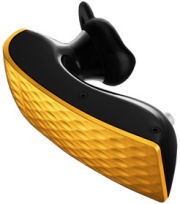 |
For example, the Aliph Jawbone Prime features an "invisible" button design with a subtle texture, in vivid "Ear Candy" colors as a lifestyle statement for all-day users ($129, www.jawbone.com). It's particularly good for heavy users on the go who can mind-meld with its "invisible" button interface (and don't mind the custom charging cable).
|
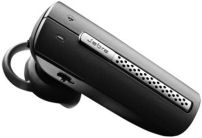 |
The Jabra BT530 has a straightforward design with clearly marked controls ($79, www.jabra.com). With its compact and functional design, featuring dedicated single-use buttons, it's particularly helpful for occasional use, since it's so straightforward to turn on and use.
|
 |
Or the Plantronics Discovery 975 with boom mic extension to get closer to your voice includes a protective case that doubles as a booster battery for long road trips ($129, www.plantronics.com). It has an understated design with blocky base and small boom extension. It's good for extended use, since the small charging / carrying case can triple the talk time.
|
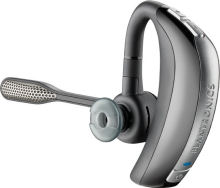 |
The Plantronics Voyager PRO has a retro over-ear design with boom mic and the electronics in a pod behind the ear, for comfortable long-term use in an office or on the road ($99). It has great voice quality and is good for long-term comfort resting on the ear, albeit not for active use.
|
|
The BlueAnt Q1 Bluetooth Headset for $87 features Voice Control (www.myblueant.com/q1) -- Click the button and speak (loudly and clearly): "Answer" or "Ignore" a call, "What Can I Say?" for a command list, or "Teach Me" for a tutorial. It has two voice isolation modes (standard and max), and supports full multipoint to connect with two phones and switch between calls. It's also firmware upgradeable via USB.
|
|
The Sound ID 400 Bluetooth Headset for $129 has custom hearing modes (www.soundid.com). with 3 PersonalSound listening modes enhance speech clarity without raising volume, and Environmental Mode to “hear-through” outside sound in between calls. And you can pair with the Sound ID Remote Microphone for $79 to listen remotely up to 30 feet to a conversation partner or sound source. |
|
The novero TheFirstOne Bluetooth Headset for $149 is designed as a premium Bluetooth earpiece (www.novero.com), with a "stylish sleek shape and white facade, brushed with subtle silver accents." It features a complete set of accessories, for the desk (AC USB wall charger, microUSB cable, Desk stand), car (DC USB Car charger, Car holder), and even as jewelry (Neck cord / necklace, Wearable clip).
|
|
The Newton Peripherals MoGo Talk is a folding earpiece with a boom that lays completely flat, so it can be stored and charged on the back of a mobile phone or inside a laptop (www.newtonperipherals.com). The MoGo Talk for iPhone protective case is $129, and the MoGo Talk for VOIP & Skype headset for $99 snaps into an Express Card 34 charging adapter. |
These portable devices make great personal media players, but aren't so useful for sharing the fun -- with small screens (not so visible off-angle) and tiny speakers. And even a laptop is not good for viewing by more than a few people.
So carry your own pocket-size projector like the second-generation 3M MPro120 Pocket Projector (4.7 x 2.4 x 0.98 inches, 5.6 ounces). This projects an image from 8 to 50 inches diagonal (up to 3 1/2 feet away). At 10 to 12 lumens it's bright enough to see in the light, and includes a built-in speaker. You can hook up to a laptop (with VGA), analog video (component A/V), or to iPods with a separate cable ($299, 3mmpro.com).
|
The similar Optima PK102 Pico Projector adds internal memory to store photos and videos ($249, www.optomausa.com).
But who needs a separate projector? The Nikon COOLPIX S1000pj 12 MP digital camera includes built-in projector. It throws a VGA-resolution image of up to 40 inches a distance of up to 6 1/2 feet, at up to 10 lumens ($429) --
www.nikonusa.com/Find-Your-Nikon/Product/Digital-Camera/26186/COOLPIX-S1000pj.html
You also can boost your audio for sharing with portable speakers.
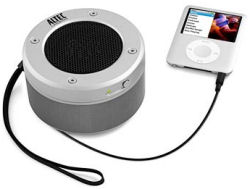 |
The Altec Lansing Orbit Speaker is a cylinder around 3 3/8 inches wide, and is available with an audio connector, or in a USB version for laptops ($39 / $49, www.alteclansing.com).
|
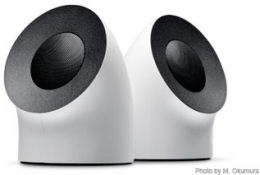 |
The LaCie USB / FireWire Speakers provide 1watt each of stereo sound for laptops in a curvy design about 5 1/3 x 4 inches, powered over USB or FireWire ($29 / $79, www.lacie.com).
|
 |
The new OrigAudio Fold and Play Recycled Speakers are only $16, and are made of heavy-duty recycled paper (www.origaudio.com). They fold flat for travel and storage. Just open them to assemble into 3 1/8 inch cubes -- just fold in the ends and fit the tab A's into slot B's. The pair of stereo speakers are wired to a standard 3.5mm headphone jack, which plugs into almost any audio device, desktop or portable. And they are are self-powered, so no batteries or external power is needed. |
Why is it so hard to build portable electronic devices that use a standard power / data plug? After all the "U" in USB stands for Universal, and lots of products do fine with it. Of course, there are three sizes of USB connectors -- full-size USB (on laptops), mini USB (on some players and phones), and micro USB (on Bluetooth headsets and phones), so you'll need cables for each. But with USB wall adapters and car adapters, as well as USB-based portable batteries, things are getting at least a little simpler.
But no such luck when you head out on a trip, and you find yourself packing multiple power supplies with special connectors for devices like a Nokia phone, Apple iPod player, Sony camcorder, and Dell laptop. Yeesh!
 |
One alternative is to carry one power supply or rechargeable battery with a system of interchangeable tips for powering your various devices. The Energizer Energi To Go XP line of Rechargeable Power Packs which supports both USB and swappable tips, so you can recharge on the go to extend your time on the road (www.energizerpowerpacks.com). The line includes the credit-card sized 1.3 oz. XP 1000 with tips for cell phones, Apple iPods, and other MP3 players Bluetooth headsets though mini/micro USB ($19), and the 2.5 oz. XP 2000 charges smartphones, plus gaming devices and even digital cameras ($39). [The model number is the mAh capacity.] For larger digital cameras, the 5.4 oz. XP 4001 charges two devices at once ($59), and the 4.9 oz. XP 4000 adds tips for camcorders to charge up to 6 hours, plus a EZ-Charger clip that charges internal batteries ($79). And for portable computing, the 7.9 oz XP 8000 also charges netbooks for to 3 hours ($99), and the 17.5 oz XP 18000 charges laptops up to 6 hours ($179). |
Instead of trying to assemble and track custom adapter tips for all your various devices, you can use chargers with USB and/or mini USB ports for compatibility with the growing number of USB-powered devices. The portable battery itself can be recharged through USB (from a computer or USB wall charger). And for other devices with custom interfaces (like Apple iPods), you can just use the USB adapter / cable that came with the device.
 |
For example,. the Duracell Power Reserve line of portable chargers are rechargeable Lithium Ion batteries packaged in several sizes to provide additional power on the road for portable devices, from cell phones to media players to even some digital cameras (www.duracell.com/us/smartpower/products_PowerReserve.asp). The Duracell Pocket Charger ($19) is a 500 mAh pocket-sized, supplemental charger for cell up to 60 percent more talk time on cell phones. The Duracell Instant Charger ($29) is a small (~ 3 1/2 x 1 1/2) 1500 mAh charger with a USB port, plus miniUSB (and cable) for charging. It provides up to 180 minutes of backup power for cell phones and the iPhone, and 45 to 50 hours for iPods like the nano and classic. The Duracell Powerhouse Charger ($49) is a 2000 mAh device that can charge two devices at once, with a USB port and miniUSB arm. It provides reserve power for cell phones, PDAs or MP3 players, and even many digital cameras. Find the Duracell Pocket Charger, Instant Charger, and Powerhouse Chargeron Amazon.com |
But there's still all the different power adapters and cables required to keep our portable devices charged. Yet if everything else is going wireless, why not power? We're not talking here about pulling energy out of the air, or beaming voltage around -- The idea is that you can just sit your device down on the table and it charges, without the muss and fuss of wires and connectors.
Sound good? Well, we're not quite there yet, but there are a couple companies on the path. The first products have a charging mat that you plug in the conventional way, plus compatible sleeve adapters that you attach to your portable devices. They also include universal adapters with micro USB interfaces.
These typically charge at the same rate as the device's own charger. And no, they don't spark if you put metal on them, or fry you if you touch them...
Of course, these products use incompatible technologies, so there will be a shake-out period in the market as the companies push to get their technology built in directly to portable devices. Someday we'll expect everything from conference room tables to kitchen counters to supply power.
 |
Powermat uses magnetic induction technology, so your device snaps into position on the mat (www.powermatusa.com). The Powermat Home & Office Mat and foldable Portable Mat are each $99. iPhone / touch Receivers are $39, BlackBerry Battery Doors and Nintendo DSi / DS Lite Backs are $29.
|
 |
The Wildcharge system available as the Duracell MyGrid uses conduction technology, with direct contact (www.duracell.com/us/mygrid). The very thin myGrid Pad is $49, and Skins are $34 for iPhone, iPod Touch, BlackBerry, Motorola RAZR V3.
|
All these devices depend on flash memory to provide storage that is lightweight, and relatively inexpensive for significant capacity (10's of megabytes). Many also provide a memory card slot for additional storage, with postage-stamp SD cards for cameras and fingernail microSD for phones and players.
Memory cards also come in more expensive higher-speed versions, but these are only needed if your device requires such performance, for example for recoding HD video or shooting bursts of high-res photos. And the new SDXC (eXtended Capacity) format promises even higher capacities, beyond 32 GB up to 2 TB on a chip (a terabyte is 1000 billion).
Another portable device, the USB "thumb" drive, has replaced floppy disks and CDs as convenient portable storage for backup and sharing.
 |
New "system in package" technology has squeezed all the electronic components into a single miniaturized sealed unit, so USB drives like the Verbatim Tuff-'N'-Tiny can fit 8 GB in half the size of a SD card (around $29, www.verbatim.com).
|
 |
Or to carry your storage more conventionally, the LaCie iamaKey is a standard-size metal key with a USB interface on the end, holding up to 32 GB for $99 (www.lacie.com).
|
For larger capacities, for example to back up photos and video clips on trips, portable hard drives jump from tens to hundreds of gigabytes. These drives are powered though the USB port, so no extra cable is required.
 |
The Western Digital My Passport line offers capacities up to 1 TB for $249, in a still highly portable size (4.3 x 3.2 x 0.7 inches, 7 ounces, www.wdc.com).
|
 |
The Verbatim InSight Portable USB Hard Drive has an always on cholesteric display that shows drive name and available free space, even when powered off. It's available with up to 500 GB for $149 (~ 6 x 3.4 x 0.63 in., under 6 oz, www.verbatim.com).
|
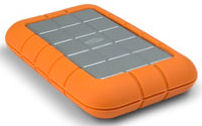 |
Or for more rugged uses (like college students), shock-resistant hard drives like the LaCie Rugged Hard Disk are available in up to 500 GB for $139.
|
But why worry about carrying and syncing your data at all? Just store it in the online cloud -- and even for free, with your Google services: Gmail, Contacts, Calendar, and now Tasks, plus Google Docs (http://docs.google.com).
Or sign up with an online service like Wuala, which securely backs up your computer files online, so you can then access them from anywhere, and share them with others as desired. (Wuala now part of LaCie, which wanted to extend its business beyond physical disks, www.wuala.com.)
Computer Accessories are also taking advantage of wireless technology
Laser mice can work great on a variety of unusual surfaces, from the fabric on the couch to the jeans on your leg. But traditional lasers just don't work well on some common surfaces, like high-gloss desktops or glass-topped tables.
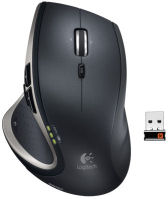 |
The Logitech Performance Mouse MX and Anywhere Mouse MX, with Logitech's Darkfield laser tracking works even on glass or transparent plastic. Instead of depending on the texture details of the surface, Darkfield uses an invisible infrared laser that detects microscopic particles and micro-scratches on surfaces. The Performance Mouse MX is full-sized, with a scooped right-handed shape, for $99.. It uses a single rechargeable AA battery, and recharges through USB (www.logitech.com/performancemx). The Anywhere Mouse MX is the compact portable version that runs on two AA batteries (or just one in a pinch), for $79.
|
Even though laptops have touch pads, it's still often more convenient to use a separate mouse. But you may find that full-size mice are bulky for travel, and miniaturized mice are uncomfortable for prolonged use.
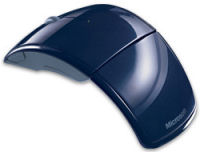 |
The Microsoft Arc Mouse is designed as a smooth arc so you can rest your hand comfortably. But the real trick is the crease down the middle -- a solid hinge that lets you fold up the tail end of the mouse to reduce it to about 3/5 of the full length, about 3 x 2 1/4 x 1 inch (www.microsoft.com/hardware). The Arc Mouse uses 2.4 GHz wireless technology, so it configures automatically with the included USB micro-transceiver. For travel, the tiny transceiver tucks away in a slot under the mouse, protected when you close up the mouse. It's Mouse is available for $49, in a variety of colors.
|
 |
The Microsoft Bluetooth Mobile Keyboard 6000 -- It's thin, light ... and curvy. It's only a few millimeters thicker than a AAA battery at the back, and then tapers toward the space bar and front edge. It's around 14 x 6 1/2 x 1/2 inches and weighs 14 1/2 ounces. And it's curved, for natural wrist position, including the individual rows of keys, so the design takes up less space than adding a curved palm rest or using split blocks of keys (www.microsoft.com/hardware). The Mobile Keyboard is priced at around $89, including a separate portable Number Pad. Both use Bluetooth wireless technology to connect to your PC or laptop, so you can go mobile without requiring a separate transceiver dongle.
|
 |
The Verbatim Easy Riser line of adjustable-height mobile mice are not quite transformers, but do jack up to provide for more comfortable handling. The mice close up for travel into a basic tapered block with rounded edges. Lift up the back to provide more height and a better fit for your hand. Verbatim Easy Riser Bluetooth Wireless Mouse is $39, the Nano Wireless Mouse for $34 uses a separate small 2.4GHz wireless receiver, and the USB Retractable Wired Mouse for $19 has a long retractable cord.
|
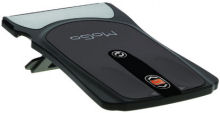 |
But for the ultimate in portability, the MoGo Mouse line from Newton Peripherals -- business-card sized mice so thin that they dock in the PC Card or ExpressCard slot of your laptop (www.newtonperipherals.com). Just store them away when not in use, as they hibernate and recharge. Then pop them out to get to work -- They connect using Bluetooth wireless, and have a flip-out "kickstand" to lift up the back for a more natural hand position. For laptops with a PC / PCMCIA Card slot, the MoGo Mouse BT is $79, and the MoGo Presenter Mouse PC is $89 and switches modes to become a wireless control for PowerPoint presentations. For laptops with an ExpressCard / 54 slot, the MoGo Media Mouse X54 is $89, with the ability to control iTunes, Windows Media Player and other media players, and the MoGo Presenter Mouse X54 Pro is $89 with a laser pointer.
|
Expanded from my annual gadget guide article in the U.S. 1 Newspaper, Nov. 25, 2009:
|